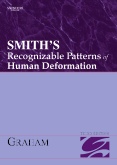|
|
|
| |
 |
|
|

|
 推薦指數:
推薦指數:





|
|
- 內容介紹
|
Smith's Recognizable Patterns of Human Deformation, 3rd Edition
By John M. Graham, Jr., MD, ScD
384 pages 862 ills
Trim size 7 1/4 X 10 1/4 in
Copyright 2007
Description
Smith’s Recognizable Patterns of Human Deformation is the only book devoted to the diagnosis and management of birth defects resulting from mechanical forces in late gestation. It equips you with the evidenced-based guidance you need to intervene in a timely and effective manner to avoid long-term adverse secondary consequences.
Reviews
REVIEW OF THE LAST EDITION:
"Very practically and clinically oriented…This excellent book should be in the library of all who see infants and children." – Journal of Developmental & Behavioral Pediatrics
Key Features
Guides you through the initial clinical approach to suspected deformation problems, and then walks you through pathogenesis, diagnostic features, management, prognosis, and counseling for each condition.
Addresses a full range of lower extremity deformations • joint dislocations • nerve palsies • chest and spinal deformations • head and neck deformations • craniosynostoses and cranial bone variations • problems associated with abnormal birth presentation, birth palsies, and procedure-related defects • infant head shape variations and torticollis.
Helps you to distinguish deformations from malformations so you can manage them appropriately.
Table of Contents
INTRODUCTION
1. Clinical Approach to Deformation Problems
PATTERNS OF DEFORMATION
Foot Deformations
2. Foot Deformations: General
3. Calcaneovalgus (Pes Planus)
4. Metatarsus Adductus (Metatarsus Varus)
5. Talipes Equinovarus (Clubfoot)
6. Deformed Toes
7. Flexible Flatfoot
Other Lower Extremity Deformations
8. Tibial Torsion
9. Femoral Anteversion
Joint Dislocations
10. Joint Dislocation: General
11. Developmental Dysplasia of the Hip (Congenital Dislocation of the Hip)
12. Knee Dislocation (Genu Recurvatum)
13. Dislocation of the Radial Head
Neurapraxias (Palsies)
14. Facial Palsy
15. Brachial Plexus Palsy
16. Diaphragmatic Paralysis
17. Other Peripheral Nerve Palsies
Thoracic Cage and Spinal Deformations
18. Lung Hypoplasia
19. Pectus Carinatum or Excavatum
20. Scoliosis
Head and Neck Deformations
21. Nose Deformation
22. External Ears
23. Mandibular Deformation
24. Congenital Muscular Torticollis
25. Torticollis-Plagiocephaly Deformation Sequence
26. Infant Sleeping Position and Sudden Infant Death Syndrome
27. Positional Brachycephaly
28. Other Postnatal Head Deformations
Craniosynostosis
29. Craniosynostosis: General
30. Sagittal Craniosynostosis
31. Coronal Craniosynostosis
32. Metopic Craniosynostosis
33. Lambdoidal Craniosynostosis
34. Multiple Sutural Craniosynostosis
Cranial Bone Variations
35. Vertex Birth Molding
36. Craniotabes
37. Anterior Fontanelle Bone
38. Parietal Foramina
39. Aplasia Cutis Congenita
40. Cephalohematoma
41. Wormian Bones
Abnormal Birth Presentation
42. Breech Presentation Deformation
43. Transverse Lie Deformation
44. Face and Brow Presentation Deformation
Whole Body Deformation
45. Small Uterine Cavity Deformation
46. Oligohydramnios Sequence
47. Fetal Akinesia Sequence
48. Abdominal Pregnancy (Extrauterine Pregnancy)
49. Early Embryonic Compression/Disruption
50. Obstetric Procedure-Related Defects
MECHANICS IN MORPHOGENESIS
51. Principles of Human Biomechanics
|
|
|

